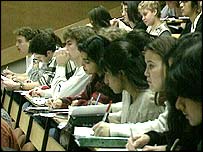|
|
|
LCS Student information

Fourth
year projects click here
for information on projects
Lecture
notes click on links for lecture
notes (password required)
Lifespan
(yr 1/4)

SZ lecture
1, Week
2,
Week
3
Developmental
Studies - Psychology
(yrs 1/2 & 2/4)

GP
lecture 1, Lecture
2,
Lecture
3,
Exams
Michelle
Pettinato lecture 1, Lecture 2, Lecture
3.
Developmental
Studies - Language (yr 1/2)

Overview,
Week 1, Week
2, Week 3, Week
4, Week
5, Exams
NEW
Information regarding LANGUAGE IMPAIRMENT
10
things students should know about children with specific
language impairment
Specific Language
Impairment has been actively studied for more than 40 years. Language
acquisition is the primary area of concern as the child grows and develops.
There are no obvious related causes such as hearing loss or low IQ. The
condition appears in young children and is known to persist into adulthood.
Although the causes are unknown, current research focuses on possible inherited
tendencies. Early identification and intervention are considered best practices,
in order to minimize possible academic risks.
- Specific Language
Impairment has many names and it is surprisingly common.
SLI is
just one of the many communication disorders that affect more than 1 million
students in the public schools. If your child has been evaluated by a speech
pathologist, you may have heard its other names: developmental language
disorder, language delay or developmental dysphasia. Specific language
impairment is the precise name that opens the door to research about how to
help a child grow and learn.
SLI is more common than you might think. Research
over the past ten years has generated accurate estimates of the numbers of
young children that are affected by SLI. We now know it could be as high as
7 to 8 percent of the children in kindergarten. In comparison, Down syndrome
or autism affects less than one percent of the five-year olds.
- Late talking may be
a sign of disability.
As they enter their two's and grow into three and
four, children have a remarkable number of ways to tell adults what they
need. Even if the words don't all sound right, a normally developing child
will make many efforts to communicate and will make his point effectively.
Young children ask so many questions -- often exhausting their parents and
care providers. Children who don't ask questions or tell adults what they
want may have a communication disorder.
Children with SLI may not produce any words until they are nearly two
years old. At age three, they may talk, but can't be understood. As they
grow, they will struggle to learn new words, make conversation and sound
coherent.
Today,
research is underway to determine which children do not outgrow this
pattern of delayed speech. By age 4 to 5 years, SLI could be a signpost of
a lasting disability that persists throughout the school years.
- A child with SLI
does not have a low IQ or poor hearing.
Several other disabilities involve difficulties
communicating, but for these children the primary diagnosis will be mental
retardation, or autism, or hearing loss, or cerebral palsy. A child with
SLI scores within the normal range for nonverbal intelligence. Hearing
loss is not present. Emerging motor skills, social-emotional development
and the child's neurological profile are all normal. The only setback is
with language. SLI is the primary diagnosis.
- Speech impediments
are different from language disorders.
A child with a speech disorder makes errors in
pronouncing words, or may stutter. Recent studies find that most children
with SLI do not have a speech disorder. SLI is a language disorder. This
means that the child has difficulty understanding and using words in
sentences. Both receptive and expressive skills are typically affected.
- An incomplete
understanding of verbs is an indicator of SLI.
Five-year old children with SLI sound about two
years younger than they are. Listen to the way a child uses verbs. Typical
errors include dropping the -s off present tense verbs and asking
questions without the usual "be" or "do" verbs. For
example, instead of saying "She rides the horse" the child will
say "She ride the horse." Instead of saying "Does he like
me?" the child will ask "He like me?" Children with SLI
also have trouble communicating that an action is complete because they
drop the past tense ending from verbs. They say, "She walk to my
house yesterday" instead of "she walked to my house."
- Reading and
learning will be affected by SLI.
SLI does affect a child's academic success,
especially if left untreated. Forty to seventy-five percent of the
children have problems learning to read.
- SLI can be
diagnosed precisely and accurately.
In the last ten years, researchers have documented the ways that SLI
occurs. Clinical practice is catching up to these advances in research. In
the past, SLI has not been included on educational classification systems
used by speech pathologists or psychologists, and when identified, it was
called a language delay.
In 2001, the Psychological Corporation released the first comprehensive
test for SLI. The Rice/Wexler Test
of Early Grammatical Impairment is based on research funded by the
National Institutes of Health, and carried out at the University of Kansas
and the Massachusetts Institute of Technology. Speech pathologists and
preschool educators can use this test with children ages 3 to 8. It will
point to the specific gaps in a child's language abilities so that
treatment can be more effective. It is especially useful for identifying
children with SLI at the time of school entry.
- The condition may
be genetic.
The genetic origin of SLI has not yet been proven,
but studies show that fifty to seventy percent of children with SLI have
at least one other family member with the disorder. Several researchers
are studying twins, looking for the genetic link. In 2001, British
researchers successfully found the chromosome that affected 15 of 37
members of a London family with a profound speech and language impairment.
- The nature of the
disability limits a child's exposure to language.
Children with SLI need extra opportunities to talk
and to listen, but because of the disability, they may actually have fewer
chances. At a young age, curious children ask questions over and over as
they see, touch, and experience the world. The adults in their life
respond, giving them vocabulary and grammar in a spontaneous teaching
format. A child with SLI has trouble asking "Do you?" and says
instead "You like ice cream?" This kind of question is easily
misunderstood. A child who cannot get the message across may simply stop
trying. Interactions are especially difficult with other children because
they are less supportive and patient than adults.
- Early intervention
can begin during preschool.
By age five, parents can secure a conclusive
diagnosis, but being proactive in the preschool years is often time well
spent. Equipping a child for success at ages three and four will lead to
positive experiences in kindergarten -- and the signs of SLI are present
by age three.
Some preschool programs are designed to enrich the
language development of students with disabilities. This classroom may
include normally-developing children who will act unknowingly as models.
The focus of class activities may be role-playing, sharing time, or
hands-on lessons with new, interesting vocabulary. This kind of preschool
will encourage interaction between children, and will build rich layers of
language experience. It may even include techniques from speech pathology
that solicit from children the kinds of practice they need to build their
language skills.
Parents can also send their preschool child to a speech or language
pathologist in private practice. This professional can assess the child's
needs, engage in structured activities, and can send home materials for
enrichment.
This fact sheet was
written by Joy Simpson in collaboration with Mabel
L. Rice, an international expert on language disabilities in children. Dr.
Rice is the Fred and Virginia Merrill Distinguished Professor of Advanced
Studies at the University of Kansas.
References
Leonard, L.B. (1998). Children with specific language
impairment. Cambridge, MA: MIT Press.
National Information Center
for Children and Youth with Disabilities, fact sheet number 11 (FS11), January
2004. www.nichcy.org/pubs/factshe/fs11txt.htm
Rice, M. L. (2002). A
unified model of specific and general language delay: Grammatical tense as a
clinical marker of unexpected variation. In Y. Levy and J. Schaeffer
(Editors), Language competence across populations: Toward a definition of
Specific Language Impairment, (pp. 63-95). Mahwah, New Jersey: Lawrence
Erlbaum.
Rice, M. (2000). Grammatical
symptoms of specific language impairment. In D.V.M. Bishop and L.B. Leonard
(Editors) Speech and language impairments in children: causes,
characteristics, intervention and outcome (pp. 17-34). East Susex, England:
Psychology Press.
Rice, M. and Wilcox, K.
(Editors) (1995) Building a language-focused curriculum for the preschool
classroom: a foundation for life-long communication. Baltimore: Brookes
Publishing Company.
Schuele, C.M. and Hadley, P.
(1999). Potential advantages of introducing specific language impairment to
families. American Journal of Speech-Language-Pathology, 8, 11-22.
Tager-Flusberg, H. and
Cooper, J. (1999). Present and future possibilities for defining a phenotype
for specific language impairment. Journal of Speech, Language, and Hearing
Research, 42, 1275-1278.
Tomblin, J.B. (1997).
Prevalence of SLI in kindergarten children. Journal of Speech, Language, and
Hearing Research, 40, 1245-60.
|
|



